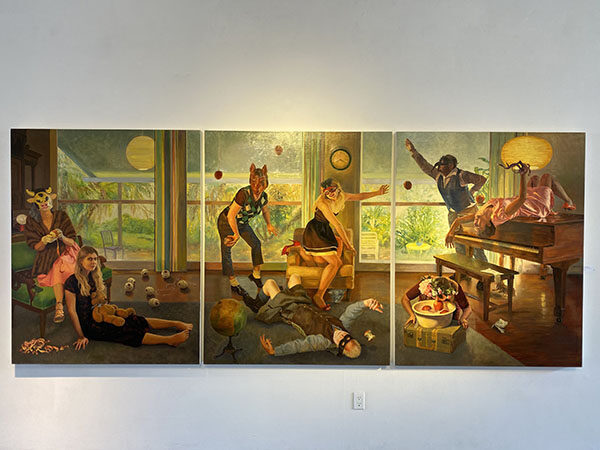A full moon hangs demurely in the upper left of Serena Potter’s painting Nighttiming (2019) like a wheel of Babybel cheese. Beneath it, on the crest of a forested hill, a scene of lunar revelry: a man and woman in office attire, and another woman in striped pajamas and hair curlers, giddily playing on a swing set. A small search party emerges with lanterns from the dark shrubbery, looking bewildered, while Downtown glows in the valley below. This is a modern world, but one in the sway of older and stranger powers. Nighttiming and 21 other paintings by Potter are on view at the Lois Lambert Gallery for “Fables of Rhyme and Reason,” a dual exhibition with painter Cynthia Sitton.
The carnal and the uncanny dominate Potter’s paintings in a nostalgic Americana-style depicting masked human figures—from horse heads to bull faces to plague doctor-style black beaks—amidst cozy domestic interiors. There’s a particularly Californian spookiness to her paintings, which take inspiration from Potter’s Culver City upbringing. Magic and menace swirl through the large Southern California home she’s summoned, reminding us that Los Angeles gave us American fables like The Wizard of Oz, King Kong and E.T. the Extra-Terrestrial, as well as the breeding ground for some of the world’s most infamous and fantastical cults. After all, Southern California was historically the nation’s sanitorium, home to “remarkable numbers of sick and doomed people” per historian Mike Davis. Herb Caen, the 1970s newspaper columnist, commented on its status as America’s “kook capital” thusly: “We who have lived here a long time resist that description […] What others call kooks we look upon as characters in a charade we smile at.”

Serena Potter, Masquerade Triptyque, 2019. Courtesy Lois Lambert Gallery.
There is a great deal of smiling in these paintings, but what is captured so well by Potter’s brush is the moment that fear pervades a room. That it is daytime, with gentle yellow sunlight painted like butter in the window, does not lessen the unease of confronting a disguised face; Potter’s paintings are choked with the kind of invisible malevolence that seems to emanate from certain hallways or rooms in childhood. Entrenched in Potter’s scenes are the sense of pretend-play that’s just about to go too far, or the pulse of fear that will grip a child who suddenly finds themself alone. The adrenalized gaze locks down the scene of the painting, as the dilated, roving pupil of one frozen in place takes in all the details of a particular scene that, for whatever unutterable reason, has created a sense of mortal threat. This particularly frozen quality of her paintings, despite their warm tones and dynamic compositions, likely comes from Potter’s predilection for photo references—on average she will use 12 to 15 per painting. If we assent to Roland Barthes’s idea that photography kills the subject, the ones gazing out from Potter’s paintings are already “really, most sincerely dead.”


